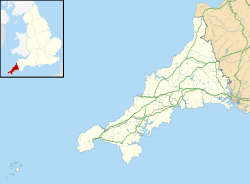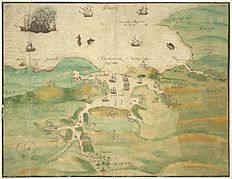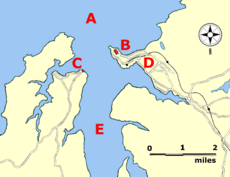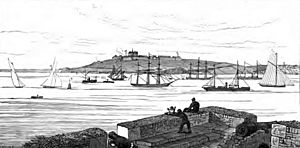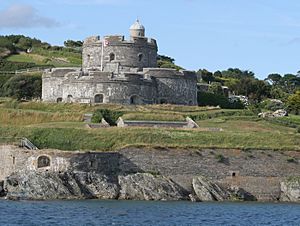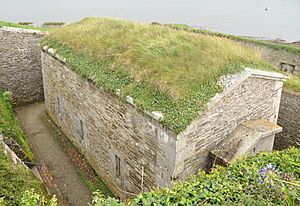St Mawes Castle facts for kids
Quick facts for kids St Mawes Castle |
|
|---|---|
| Falmouth, Cornwall, England | |
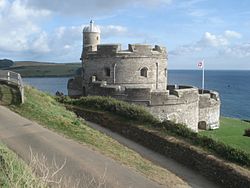
The Henrician castle, seen from the landward side
|
|
| Coordinates | 50°09′17″N 5°01′26″W / 50.15486°N 5.02377°W |
| Type | Device Fort |
| Site information | |
| Owner | English Heritage |
| Open to the public |
Yes |
| Condition | Intact |
| Site history | |
| Built | 1540–42 |
| Built by | Thomas Treffry |
| In use | English civil war. |
| Materials | Slate rubble, granite |
| Events | English Civil War, Second World War |
| Official name | St Mawes Castle |
| Designated | 9 October 1981 |
| Reference no. | 1013807 |
|
Listed Building – Grade I
|
|
| Official name | St Mawes Castle, gatehouse, blockhouse, magazine and outer defences |
| Designated | 25 June 1985 |
| Reference no. | 1136705 |
St Mawes Castle (Cornish: Kastel Lannvowsedh) is an old fort built by King Henry VIII near Falmouth, Cornwall. It was constructed between 1540 and 1542. This castle was part of the King's plan to protect England from attacks by countries like France and the Holy Roman Empire. It guarded the Carrick Roads waterway, which is the mouth of the River Fal.
Thomas Treffry oversaw the building of St Mawes Castle. It has a unique clover leaf shape with a tall central tower and three round parts sticking out, which were used for cannons. The castle first had 19 cannons to fire at enemy ships. It worked together with Pendennis Castle, which is on the other side of the river mouth.
During the English Civil War, St Mawes Castle was held by the King's supporters, called Royalists. But in 1646, it surrendered to the Parliamentary army without a fight.
The castle continued to be used as a fort for many years. In the 1850s, it was updated because of new fears of war with France and changes in military technology. The old castle became a barracks, and new, powerful gun batteries were built below it. These new batteries had the latest naval artillery.
Later, in the 1880s and 1890s, an electric minefield was placed across the River Fal. This minefield was controlled from both St Mawes and Pendennis castles. New, quick-firing guns were also added at St Mawes to help protect the minefield.
After 1905, the guns at St Mawes were removed. Between 1920 and 1939, the government ran it as a tourist attraction.
St Mawes Castle was used again during the Second World War. Naval cannons and an anti-aircraft gun were placed there to defend against possible German attacks. After the war, it became a tourist attraction once more. Today, English Heritage looks after the castle.
The castle has amazing 16th-century carvings, including sea monsters and gargoyles. Historian Paul Pattison called it "arguably the most perfect survivor of all Henry's forts." St Mawes Castle is also a protected Scheduled Monument and a Grade I listed building.
Contents
History of St Mawes Castle
Building the Castle (1500s)
St Mawes Castle was built because of problems between England, France, and the Holy Roman Empire during King Henry VIII's rule. Before this, local lords usually handled coastal defenses. The King didn't get involved much in building forts.
In 1533, King Henry VIII broke away from the Pope. This made the Holy Roman Emperor, Charles V, very angry because Henry had divorced his aunt. France and the Empire then teamed up against Henry in 1538. The Pope even encouraged them to attack England. It looked like England was going to be invaded.
To prepare, King Henry ordered new forts to be built along the English coast in 1539. This plan was called a "device".
The Carrick Roads waterway at the mouth of the River Fal was a very important place for ships coming from the Atlantic and Mediterranean. Plans were made to build five castles to protect it. In the end, only two were built: St Mawes and Pendennis. They were placed on opposite sides of Carrick Roads. Their cannons could fire across the water, protecting the area. St Mawes also watched over another anchorage on the eastern side.
Building work started in 1540. Thomas Treffry, a local gentleman, was in charge of the project. By 1542, most of the castle was finished. The whole project cost about £5,018.
The castle had a clover leaf shape with a small blockhouse (a strong building) closer to the water. It was armed with 19 cannons, including large ones like demi-cannons and demi-culverins. These cannons were meant to sink enemy ships. A smaller blockhouse was built at sea level, possibly even before the main castle, for early protection. The castle usually had a small group of soldiers. Local volunteers would join them if there was an emergency.
Early Years of Operation (1500s-1600s)
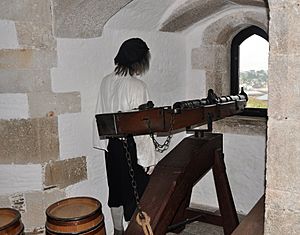
Michael Vyvyan was the first captain of St Mawes in 1544. After him, his son Hannibal Vyvyan took over in 1561. When Hannibal died in 1603, his son, Sir Francis Vyvyan, became captain. The captains of St Mawes and Pendennis castles often argued. In 1630, they had a legal fight about who had the right to check ships coming into the harbor. The Admiralty decided they should share the duty. Sir Francis was removed from his job in 1632. He was accused of cheating, like claiming wages for soldiers who didn't exist.
The threat of invasion from France passed, and peace was made in 1558. However, the threat from Spain in the south-west of England grew. War started in 1569, and the number of soldiers at St Mawes was increased to 100 in 1578. An extra battery of guns was built to fire further upriver.
Fears of a Spanish attack continued, especially after the failed Armada of 1597. Two earth and timber forts were built out from the stone castle to hold more guns. By 1623, the castle had several cannons and a small group of 14 soldiers. A check in 1634 showed the castle needed repairs.
English Civil War and After (1600s)
When the English Civil War began in 1642, St Mawes and the south-west of England were controlled by the King's supporters, the Royalists. The town of Falmouth was important for their supplies.
By March 1646, the Parliamentarian army, led by Thomas Fairfax, entered Cornwall. Major Hannibal Bonithon, the captain of St Mawes, was asked to join the stronger Pendennis Castle. But Bonithon and his men quickly surrendered to the Parliamentarians without fighting. This might have been because they were tired of war, or because there were so many Parliamentarian soldiers. The Parliamentarians captured 160 small arms and 13 cannons. The castle's guns were then used to help attack Pendennis Castle, which fell later that year.
St Mawes Castle was then put on "care and maintenance," meaning it had only a few soldiers. After King Charles II returned to the throne in 1660, Sir Sir Richard Vyvyan, 1st Baronet, Sir Francis's son, took command. He thought his 13 soldiers were not enough. His son, Sir Sir Vyell Vyvyan, 2nd Baronet, became captain next. He sold the castle's lands to John Granville.
Later Years and Updates (1700s-1900s)
St Mawes Castle continued to be used as a fort through the 1700s and 1800s, still working with Pendennis Castle. In the 1730s, St Mawes had 17 cannons. Wars with France in the late 1700s made defending Falmouth very important. By the 1780s, the castle had over 30 large cannons. However, inspections often found that many guns were not working well.
In 1796, a new gun battery was built at St Anthony Head, near St Mawes. For a while, this battery became the main defense on the east side of the river. The poet Lord Byron visited in 1809 and joked that St Mawes was "extremely well calculated for annoying every body except an enemy." He also said only one old man was guarding it. After the Napoleonic Wars ended in 1815, the St Anthony's battery closed, but St Mawes stayed open with minimal staff.
Falmouth Harbour became a very important port in the 1800s, especially for ships crossing the Atlantic. In the early 1850s, fears of war with France led to a review of the harbor's defenses. New ironclad warships with powerful rifled guns meant St Mawes needed big changes.
A new Grand Sea Battery and magazine (for gunpowder) were built below the old castle. These were connected by deep tunnels. They had powerful new cannons. The old castle was used as a barracks for soldiers. St Mawes was often used as a training base for local soldiers.
More worries about France came up in the 1880s. An electric minefield was placed across Carrick Roads in 1885, controlled by both St Mawes and Pendennis. New quick-firing guns were added to St Mawes in the 1890s to stop fast torpedo boats or mine sweepers. Another battery for quick-firing guns was built above the castle between 1900 and 1901.
Modern Times (1900s-Today)
In 1905, it was decided that the cannons at St Mawes were no longer needed. The guns could be placed at Pendennis and St Anthony's instead. Without its guns, St Mawes was used as a barracks during the First World War. In 1920, the castle was taken over by the government and opened to visitors. The Great Western Railway company even promoted it to encourage tourism.
When the Second World War started in 1939, the British Army took over St Mawes again. In 1941, new cannons and a Bofors anti-aircraft gun were installed near the castle. Searchlights were also added. Some of the 115 soldiers lived in a local Nissen hut, while others stayed in the castle itself.
The castle was taken out of active service in January 1945 and reopened to the public the next year. The Second World War gun battery closed in 1956. Between 1945 and 1970, much of the Victorian defenses were removed from the Grand Sea Battery.
Today, English Heritage operates St Mawes Castle as a popular tourist attraction. It is protected by UK law as a Scheduled Monument.
Castle Architecture
St Mawes Castle is on a piece of land sticking out into the Carrick Roads. Higher land is behind it. At the top of the site are the castle entrance, the high-level gun batteries, and the 16th-century Henrician Castle. The land slopes down to the water, where more gun batteries and a 16th-century blockhouse look out over the water.
The Henrician Castle
The main castle is built from slate stone and granite. It has a clover leaf shape with a central, four-story round tower, or keep, and three round parts called bastions sticking out. This design allowed for cannons on different levels. The castle had little protection on the land side, so local volunteers would have helped defend it from that direction. The castle hasn't changed much since it was built. Historian Paul Pattison calls it "arguably the most perfect survivor of all Henry's forts."
The castle is decorated with many carvings and writings in stone and wood. These praise King Henry VIII and his family. Historian A. L. Rowse said it was the most decorated of all Henry's buildings. You can see Latin verses, like "Henry, thy honour and praises will remain forever." There are also carved sea monsters and gargoyles, along with heraldic shields that were once painted brightly.
You enter the castle through the gatehouse, a stone building about 25 feet (7.6 m) across. The gatehouse has gunloops (small openings for guns) and murder holes (openings to drop things on attackers). It might have had a drawbridge, but we don't know for sure. Behind it is a yard, which was once a stable. This leads to a stone bridge over a 7.5-meter (25 ft) wide moat cut into the rock.
The central tower is 47 feet (14 m) across and 44 feet (13 m) high, with walls 8 feet (2.4 m) thick. The basement was once a kitchen and storage. The first floor was used by the soldiers and later for storing gunpowder. The bridge leads to the second floor, which had four rooms with fireplaces. This area might have been for officers or extra soldiers. The third floor is one large room with openings for cannons. It was probably where the soldiers lived. On the fourth floor, a platform with walls could hold up to seven guns. It also has a lookout tower with a 17th-century cupola (a small dome) that helped guide ships.
The central tower connects to the front bastion, which is 18 meters (59 ft) across. Steps lead from there to the side bastions, each 16.4 meters (54 ft) across. Each bastion is a platform for cannons, with openings for larger guns and mounts for lighter ones. The front bastion's roof is new. The bastions display various cannons from the 1700s and 1800s. There's also a bronze cannon from 1560, called the Albergheti gun, found from a shipwreck.
Batteries and Other Buildings
St Mawes Castle has many gun batteries and other buildings spread across its site. Above the Henrician castle is the high-level battery, built around 1900. It has four concrete platforms for guns and an underground magazine. A small house from this time is still used by the English Heritage caretaker. Next to the Henrician castle is the Engine House, built around 1902. It once held an engine that powered the castle's searchlights.
Below the Henrician castle is a group of cannon positions called the Grand Sea Battery. These were carved out of the rock starting around 1854. The Grand Sea Battery had a 19th-century magazine for gunpowder, with thick stone walls and a bomb-proof brick roof covered with turf. There are two gun platforms, one on the west and one on the east. The western platform was updated in the 1890s for rotating guns. The eastern platform has mounts for four moving gun carriages. One of these now holds an old 12-pound cannon from 1815.
Just below the Grand Sea Battery is the 16th-century blockhouse, right by the water's edge. It's about 160 feet (49 m) from the main castle. The blockhouse is semi-circular, with thick stone walls facing the sea. It originally had four openings for guns. The upper part was later removed to make it a solid gun platform, but it has since been dug out again. Next to the blockhouse are the foundations of four searchlight positions from the Second World War.
To the west of the Grand Sea Battery are landscaped gardens, built over older gun positions. Five 19th-century cannons are on display here, used for firing salutes. Beyond the gardens is where the Second World War 6-pounder battery was, but not much of it remains today.
List of Captains
- 1544–1561: Michael Vyvyan
- 1561–1603: Hannibal Vyvyan
- 1603–1632: Sir Francis Vyvyan (removed from duty)
- 1633–1634: Sir Robert le Grys
- Thomas Howard, 21st Earl of Arundel (died 1646)
- ?–1646: Major Hannibal Bonithon (Royalist)
- 1646–?1660: George Kekewich (Parliamentarian)
- c.1650: Colonel Robert Bennett (Parliamentarian)
- 1660–?1665: Sir Richard Vyvyan, 1st Baronet
- 1665–1678: Sir Vyell Vyvyan, 2nd Baronet
- 1678–1696: Sir Joseph Tredenham
- 1696–1710: Hugh Boscawen, 1st Viscount Falmouth
- 1710–1714: Francis Scobell (Member of Parliament for St Mawes)
- 1714–1734: Hugh Boscawen, 1st Viscount Falmouth
- 1734–?1740: Major De Roen
- 1740–1745: Scipio Duroure (died in battle, 1745)
- 1745–?1765: Alexander Duroure (died 1765)
- 1765–1796: Sir Robert Pigot, 2nd Baronet
- August 1796–November 1796: Colonel Edward Morrison
- 1796–1849: Sir George Nugent, 1st Baronet


